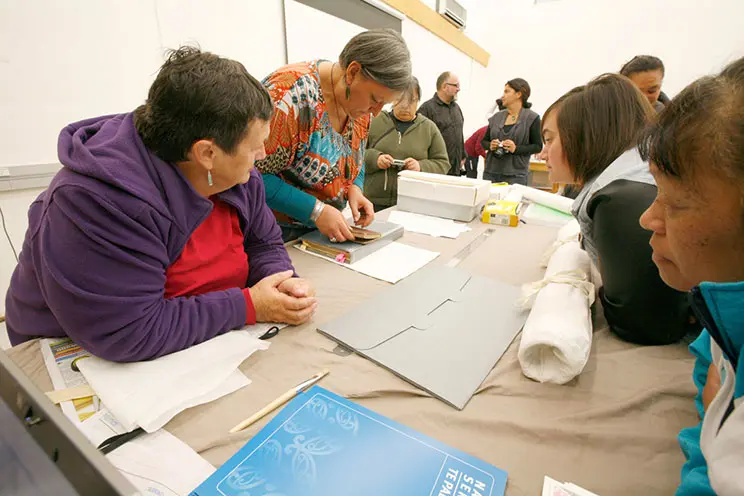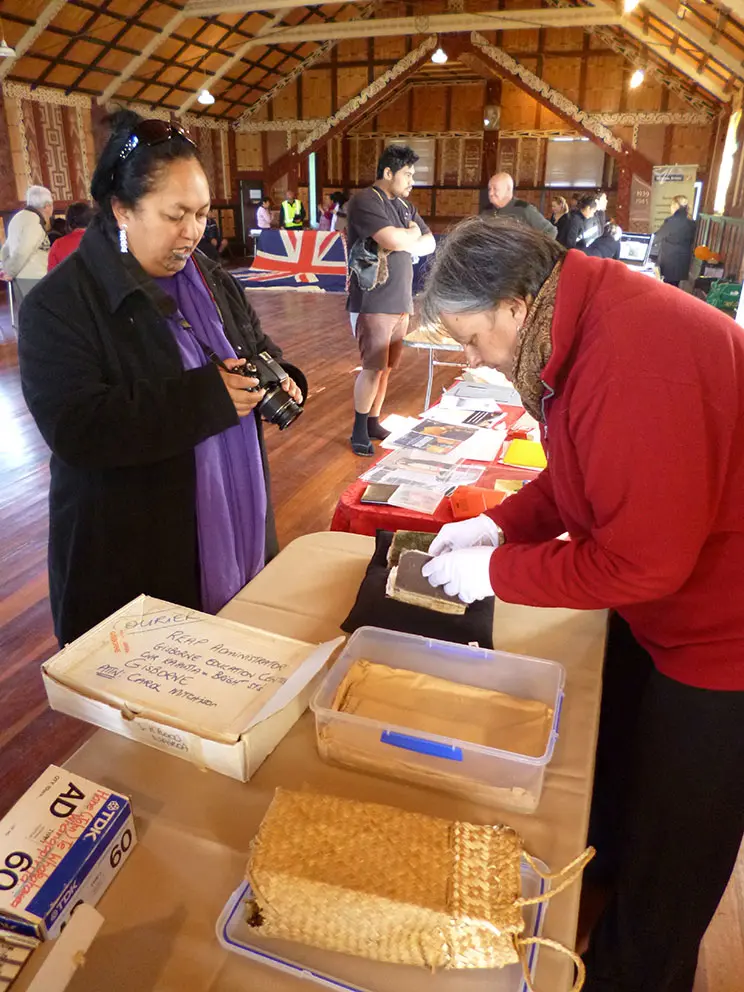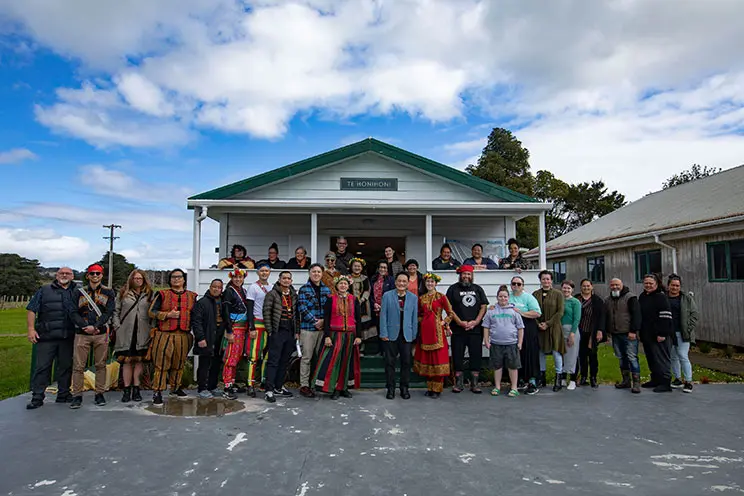Off the record | Keeping it local
Chris Szekely spoke to Vicki-Anne Heikell MNZM, whose work as a Field Conservator takes her into the community. She's found that every taonga is special and there are stories worth sharing all around the motu.
What attracted you to the world of conservation?
It was serendipitous. I had a summer. job at NZ Historic Places. Trust (Now Heritage NZ Pouhere Taonga) doing research, and I spent a lot of time in Turnbull Library Pictures. My research focused on finding as much information and as many images of whare that were going to be conserved and restored as part of the Trust's Maori Conservation programme.
As the researcher, I was able to be part of the team. that was going to be working on the whare Porourangi. Waiomatatini in the Tairawhiti. I was lucky enough to be in a team led by Cliff Whiting and Ben Pewhairangi, and two students in conservation — Dean Whiting and Nick Tupara.

Vicki-Anne Heikell demonstrates how to make enclosures at a Whanganui preservation wānanga.
I spent two weeks cleaning and removing paint layers from a pare. It was summer, it was warm, it was practical mahi and it was the Tairawhiti. Dean and Nick talked about their studies in Canberra, and I thought it sounded interesting. With no job prospects beyond my summer job, another serendipitous turn of events occurred: I saw an advertisement in the newspaper that I happened to be using to peel spuds on for scholarships to study conservation.
How did you become a conservator?
I applied for a scholarship through the Conservation Cultural Advisory Council (CCAC). My interview included wāhine toa Te Aue Davis, Wanna Davis, Ngahuia Te Awekotuku and Jeavons Baillie (the Alexander Turnbull Library’s first conservator). I was successful and headed off to Canberra in 1990 to embark on a three-year Bachelor of Applied Science in Conservation of Cultural Materials.
You were on the team when the National Preservation Office (NPO) was first established. What was it like in those early days?
The NPO was established in 1997 and was originally two positions — National Preservation Officer. Jocelyn Cuming and National Preservation Officer, Māori. I was fortunate to begin that role while Takawaenga-a-rohe Rangiiria Hedley and Hinureina Mangan were still working at the Library. They were able to support my role in their rohe. In fact, their support and the relationships established through their mahi have continued.
A lot of my mahi today is working with organisations and communities regarding the preservation of their documentary heritage collections, but also raising awareness that Alexander Turnbull Library even exists and talking about the resources we hold.
What does a typical day look like for the NPO Field Conservator?
Planning and response. It is a balancing act between providing face-to-face support and advice. and stepping back to have an overview to identify the key preservation issues and which ones the NPO and the Alexander Turnbull Library are best placed to support.

L to R: Ani Pahuru-Huriwai and Vicki-Anne doing a preservation assessment at Uepōhatu marae, Tairāwhiti.
Māori feature prominently among the NPO clientele. Why is this, and what sort of mahi does this involve?
Because I have established relationships, because it was why I was sent away to train as a conservator by the CCAC, because there is a need. Jody Wyllie, former Oral History Adviser, Māori and then the Takawaenga a-rohe, saw the need for preservation advice and information to support whānau and hapū to continue to care for their taonga.
Iwi organisations are increasingly interested in using the resources they gathered in the claims processes to be used for different purposes — to enrich their own communities through exhibitions, research spaces, and online hubs. These are all works in progress.
Sometimes the relationship bubbles away with frequent contact, sometimes it is put on the back burner-sometimes for years. In fact, just this year I am starting mahi with an iwi organisation that I last had contact with 10 years ago.
What’s the best thing about being the NPO Field conservator?
Community. Every community I work with is interested in preserving their stories. I enjoy listening to their stories; I enjoy seeing the physical item come to life when it is alongside a descendant. I used to say "Preservation is access." I tend now to say "Access is preservation" that's what engagement reveals each time I work with community.

A preservation wananga at Pukerawa Marae Hokianga with Te Papa National Services Te Paerangi. Photo by Norm Heke.
The Auckland floods, then Cyclone. Gabrielle may have impacted precious personal papers and photographs. What should be done with these?
The NPO, with support from the Library's online editor, was able to get our information out relatively quickly after the recent events, and we continue to develop those resources on our website.
Recovery for wet, muddy items: Either air-dry or, if you can't do that, freeze. Almost more damaging than the water is the mould that will take hold within 48 hours. Freezing buys you time to deal with the item later. and in more manageable numbers
No water or power: Do the best that you can with absorbent towels, and finding a spot somewhere that is the least damp. giving space to lay out your treasures. Document the damage, both for insurance purposes and for that time when you might be ready to tell the story about the event.
Time to reflect: Post-disaster will also be the time for individuals to reflect on what they might do differently in the future, for example, where and how they might store whānau treasures. It might be that they no longer want to keep the items. They can make that decision in the future, when things have settled, and they have had time and rest. If items are in the freezer or air-dried, there is a choice to keep or not to keep.
Disaster recovery resources
Drying your whānau collections — checklist
Disaster recovery checklists and resources
Disaster recovery
Thanks to Friends of the Turnbull Library
Thanks to the Friends of the Turnbull Library for permission to republish this article, which was originally published in their Off the Record print publication.
The Friends of the Turnbull Library is a national organisation that supports the work and activities of the Alexander Turnbull Library, they promote public interest in the Library’s collections and supports research and use of its collections.
More information about the Friends of the Turnbull
Our Off the record blog series will republish articles from the Off the Record magazine including stories about new acquisitions, research projects and other news about the Turnbull Library collections.